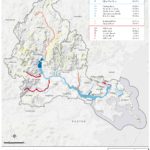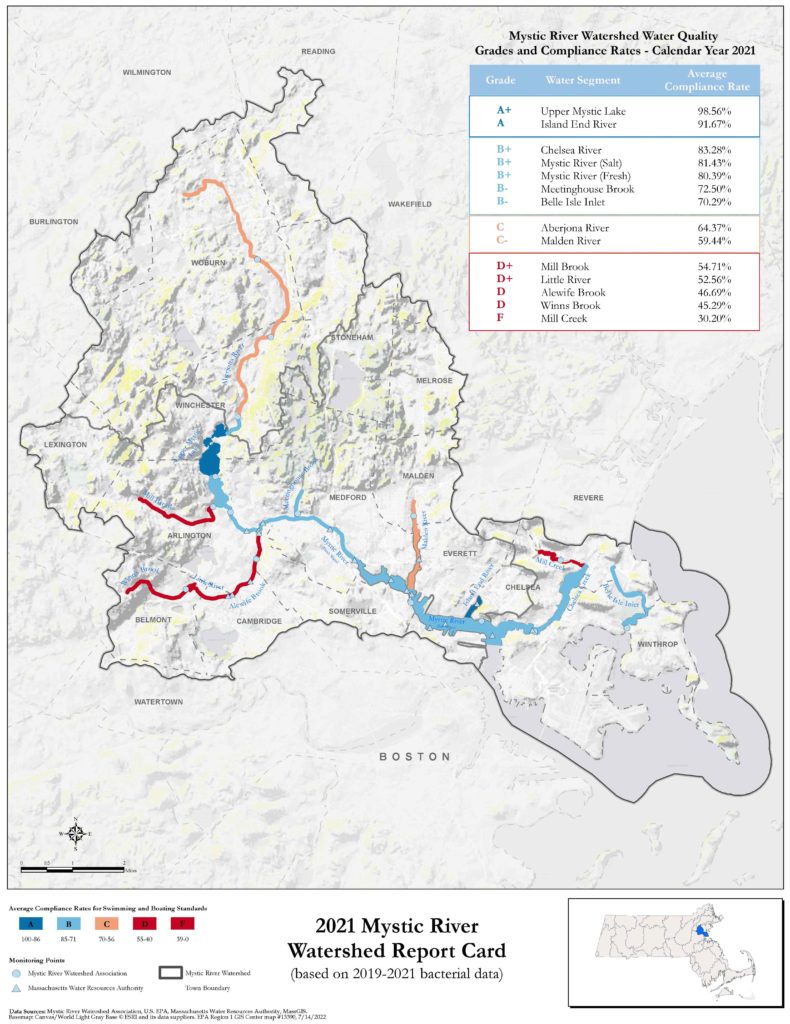
By Meg Muckenhoupt
In 1972, the Clean Water Act called for all waterways to be “fishable and swimmable” by 1983, and for all pollution discharges to end by 1985. That still hasn’t happened, as is shown by the new annual water quality report card issued by the Environmental Protection Agency (EPA) for the Mystic River in July. All of Belmont’s brooks received a D or D+ grade because they failed to meet state E. coli bacteria standards for boating in 45% to 55% of samples taken in 2021.
| Site | 2021 | 2014 | ||
| Grade | Total | Grade | Total | |
| Alewife Brook | D | 47% | D | 46% |
| Little River | D+ | 53% | D- | 40% |
| Winns Brook | D | 45% | F | 33% |
| Mystic River | B+ | 80% | B+ | 85% |
Source: EPA, www.epa.gov/mysticriver/mystic-river-watershed-report-cards
Over the course of each calendar year, the Mystic River Watershed Association (MyRWA) works with volunteers to take samples from 15 different sites to assess the river’s health. The results of those samples are reported to the EPA, which issues report cards for Boston-area rivers in July each year; the Charles River and Neponset River Watershed Associations also participate in this program.
These scores have improved slightly since the EPA started breaking out the Mystic River’s score by segment in 2014 instead of assigning a single score to the entire river. The Little River is now at least swimmable on average about 52% of the year compared to 46% in 2014, and Winn’s Brook has improved from an F to a D. However, it’s clear that there is still far too much pollution damaging Belmont’s waterways.
The 2022 report card stats reflect data from 2019–2021. The scores average each segment’s bacterial counts over three years to account for varying weather. For example, in years where there are several heavy rains, there will be more combined sewer overflows (CSOs). A CSO happens during heavy rains in towns where stormwater drains and sewage drains are connected. The stormwater reaches a high enough level inside the pipes that it sweeps raw sewage out into local waterways— including the Alewife Brook.
Cambridge still has many CSO pipes. Belmont has historically had some household sewage pipes misconnected directly to the storm drain system, and some old sewage pipes that leak into storm drain systems. (See the BCF’s Stormwater Fact Sheet and “Finding Sewer Leaks Means Detective Work,” BCF Newsletter, March 2018.)
The Mystic River is also polluted by stormwater runoff that contains car oil, dog waste, fertilizer and other lawn and yard care products, salt, and other debris. All the water that flows off roofs, roads, sidewalks, driveways, and lawns goes into storm drains which send the pollution directly into Belmont’s brooks, Little Pond, and the Mystic and Charles rivers. (See “Stormwater Threatens our Waterways,” BCF Newsletter, November 2021.)
An EPA 2017 consent order gave Belmont five years to stop underground sewage from leaking into local waterways. In 2021, Belmont continued to struggle with high E. coli counts in local streams and brooks despite extensive town work on sewer issues. (See “Belmont Has One Year to Clean up Waterways,” BCF Newsletter, May 2021.)
Meg Muckenhoupt is executive editor of the Belmont Citizens Forum Newsletter.




Sorry, the comment form is closed at this time.